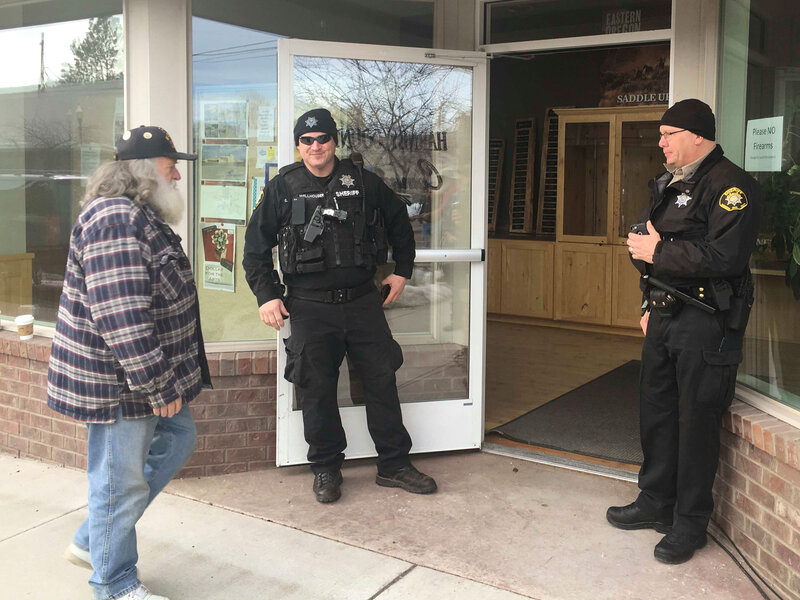In rural Oregon, wariness of extremists – and federal government overreach
Loading...
| Prineville, Ore.
The arrest of protesters who occupied federal land in central Oregon this month is just a chapter in the persistent story of tension over the use public lands in the American West.
Rancher Ammon Bundy and a handful of his supporters were arrested Tuesday, leaving an unknown number of followers without leadership in their occupation of a building in the Malheur National Wildlife Refuge.
In central Oregon and beyond, many residents of America’s inland West disagree with Mr. Bundy’s defiant tactics – occupying a federal building to protest the prison terms that two Oregon ranchers face for land-use infractions. And many don’t rally around Bundy’s view that vast Western lands really belong to states instead of the federal government.
Yet the Oregon stand-off, which gained national attention in recent weeks, is the latest symbol of deep and ongoing tension in the West over the right management and use of federal lands – which often account for the majority of acreage in rural counties.
In rural Prineville, Ore., a common refrain among residents is that federal agencies should pay more heed to local interests. In particular, they worry that environmental restrictions have overly constrained the legitimate economic uses of the lands.
"If there's empty land that could be grazed, why not use it?" says Randy Jorgensen, a resident of Prineville, as he does an errand run with toddler in tow.
"We don't have enough wildlife to eat all the grassland" and reduce the fire risks created when the foliage grows too uncontrolled, echoes Shane Quimby, who runs a mobile butchering business in the community.
A lifelong Prineville resident, Mr. Quimby sees a pattern of ever greater restrictions on public lands.
"I think the government's kind of dipping in where they shouldn't," he says, recalling a time when he enjoyed winter recreational access to the Ochoco Mountains without a permit. But now, he says, "you have to pay that $25 snow park permit just to take your kids sledding."
The concerns voiced here, in this community of 9,000-plus residents nestled in the Crooked River basin, echo similar ones held in many western regions where the economy has long hinged on activities like ranching, logging, and farming, but where efforts to protect wildlife habitat and to promote wilderness as a tourist attraction have gained growing prominence in recent decades.
The federal government owns roughly 640 million acres in the United States, or about 28 percent of the nation’s land, according to a 2014 report by the Congressional Research Service. But in eastern states the percentage is fairly low, while the share exceeds 50 percent in states like Oregon, Utah, Idaho, and Alaska, and nears that percentage in California. In Nevada, the share of lands under agencies including the Bureau of Land Management, US Forest Service, and Defense Department is a nation-leading 85 percent.
For many of these lands, multiple uses coexist – from fish hatcheries and forestry to paths traversed by cattle or all-terrain vehicles. But the phrase Sagebrush Rebellion emerged in the 1970s and 1980s to describe residents’ desire for a greater say on land use – and less designation of land as off-limits wilderness. To the perceptions of some rural westerners, the controversies over land use are being worked out over time, balancing the various interests. Others feel the conflicts have intensified in the new millennium. But in any case, the battles over land use aren’t over.
In Prineville, differing views of how federal lands should be managed flared into the open recently because of a proposal, backed by the environmental group Oregon Wild, to set up a new 312,000 acre national recreational area within the Ochoco National Forest. The plan, according to news reports, would designate some of the land as wilderness and also thwart rival plans to expand a system of trails for motorized vehicles.
"That's not going over well at all," says Jerry Crafton, who runs a Prineville business that includes tax-preparation services.
He says he doesn't agree with the occupation tactics taken by Bundy and his colleagues, but he worries about environmental interests running roughshod over the views of locals about how to use the land.
"I understand they have to do some managing of it," he says, but "blocking the land off, that's also not right."
He recalls how local lumber mills shut down years ago, costing many jobs in the area, which he blames on efforts to protect the endangered spotted owl. (Some scholars say other economic changes in the timber industry, not owl protections, were key to the job losses.) [Editor's note: This paragraph was updated to amend the description of why jobs were lost.]
Jason Ahlman, another resident who works for a local manufacturer, says Prineville used to be known for its wood products, but that now many residents need to commute elsewhere for jobs unless they are ranchers.
He worries about the impact on his community of "the attitude [that] the environment is more important than trying to support your family."








